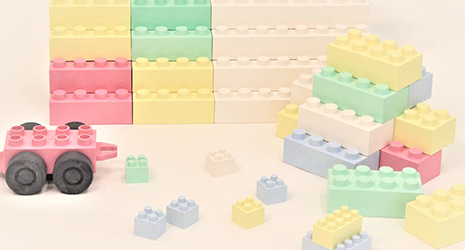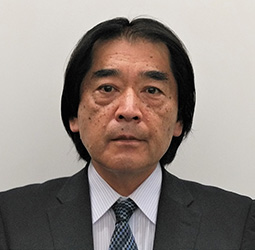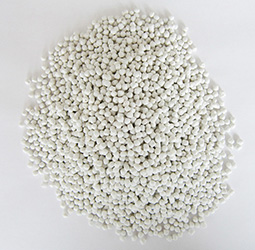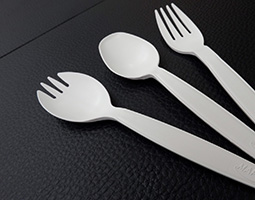February 2023
A New Replacement Material for Plastics

Toy blocks made from MAPKA 
Food containers made from MAPKA

Eco Research Institute Ltd. (ERI) President Matsushita Takamichi 
MAPKA made by mixing paper powder and polyolefin resin 
Forks and spoon made from MAPKA

A Japanese company has developed a novel paper powder-based material as a substitute for conventional plastics. Environmentally friendly with excellent performance, the new material is expected to be used in a diverse range of sectors.

Products made of plastic are all around us. However, plastics are derived from petroleum so release greenhouse gases when combusted, contributing to global warming. Furthermore, plastic waste that flows into oceans and rivers pollutes water quality and poses a threat to marine life. Measures to counter these adverse impacts of plastic waste present a global challenge.*
A novel paper powder-based material developed by Eco Research Institute Ltd. (ERI) as a substitute for plastic in response to this situation is generating a great deal of interest. MAPKA is a pellet** produced by mixing paper powder (51% or more by weight) with polyolefin resin***. Paper powder produced from wastepaper is not only a more effective use of paper resources but also significantly reduces the use of raw materials derived from petroleum.
“MAPKA was based on a foamed plastic product incorporating paper powder called Earth Republic****, which we originally developed as a cushioning material for machine parts,” says Matsushita Takamichi, President of ERI. “In order to mass produce Earth Republic, we needed the technology to achieve stable production of paper powder. When the product was first developed, we commissioned more than twenty Japanese paper mill manufacturers to test it, but we weren’t able to achieve satisfactory results. Using existing machines to pulverize the paper made it fibrous rather than powdery. Fibrous paper doesn’t mix well with plastic.”

After more than a year experimenting with different methods, Matsushita happened to walk into a soba noodles restaurant where he noticed a stone mortar being used to grind soba (buckwheat) flour. This gave him the idea for a new machine based on an entirely new concept of grinding rather than pulverizing paper. After creating the new machine, ERI succeededin achieving the stable production of fine paper powder with a particle size of 25 to 50 microns (1 micron is one thousandth of a millimeter).

The use of wastepaper generated by papermaking companies and printing plants to make paper powder enabled ERI to keep the price of Earth Republic lower than other typical foamed plastics. Moreover, such raw materials do not contain additives with a high environmental impact, with most being naturally derived, and producing no noxious gases during incineration.
The technology used to produce Earth Republic was further developed and its application expanded. MAPKA was the result. MAPKA is made by mixing equal amounts of paper powder and polyolefin resin. Its primary characteristic is that it can be molded into different shapes, just like conventional plastic materials. Since MAPKA has this feature, there is no need to replace or modify conventional plastic molding equipment to make products using the material.
In terms of attributes such as strength and lightweight properties, MAPKA is rated on a par with or superior to conventional plastic materials. In addition, at every stage of the production process, from the extraction of raw materials through to manufacture, greenhouse gas emissions can be cut by 35.1% compared to conventional plastics. Also, MAPKA products can be disposed of as burnable trash.
Moreover, because MAPKA products have a more refined appearance and higher quality feel than regular plastic products, they are more likely to be reused by consumers, which in turn reduces their environmental impact. “The first product we made from MAPKA was containers for food events. Up until that point, disposal of paper food containers that were thrown away at venues had been a significant burden on the organizers. But the superior appearance of MAPKA containers meant that the majority of visitors took them home, greatly reducing that burden,” says Matsushita.

ERI has been the recipient of numerous awards in recognition of its creative manufacturing, including the Monozukuri Nippon Grand Award and the Ministry of Environment’s Cool Choice Leaders Award. Matsushita himself was awarded the Medal with Yellow Ribbon by the Japanese Government in the spring of 2022.
MAPKA outperforms conventional plastics on a range of features, including superior environmental performance, manufacturing cost, and quality. As such, its use is expected to expand beyond food containers and household goods, which have seen strong demand, to a wide range of sectors such as automotive parts, interior finishing materials, household appliance parts, and construction materials.
* See Highlighting Japan August 2020, “A Smart Relationship with Plastic” https://www.gov-online.go.jp/eng/publicity/book/hlj/html/202008/202008_09_en.html
** Pellets are plastic granules used as raw materials for molded products.
*** Polyolefin resin is the most widely used type of plastic (resin) in our daily lives. The two most common types are polyethylene, which is used for plastic bags and tubes for foods such as mayonnaise, and polypropylene, which is used for products such as toys and sporting goods.
**** Foamed plastic is a type of plastic that contains many small air bubbles.

